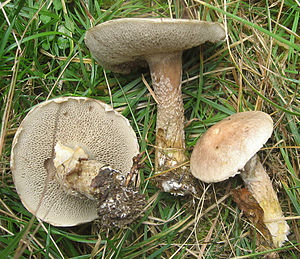Gray larch tubule
| Gray larch tubule | ||||||||||||
|---|---|---|---|---|---|---|---|---|---|---|---|---|

Gray larch boletus ( Suillus viscidus ) |
||||||||||||
| Systematics | ||||||||||||
|
||||||||||||
| Scientific name | ||||||||||||
| Suillus viscidus | ||||||||||||
| ( L. ) Roussel |
The Gray larch boletus ( Suillus viscidus ) is a mushroom from the family of Schmierröhrlingsverwandten . It is mainly found on lime-rich soils and is strongly tied to larches , to which it owes its German name.
features
Macroscopic features
The hat of the gray larch tube is four to twelve centimeters wide. At first it is hemispherical, later spread out. It is gray-greenish to brown-yellowish in color and covered with an uneven, smeary skin that is typical of the greasy tubers . In young mushrooms, it is connected to the stem by a white-gray veil, which later remains on the edge of the hat as remains of velum . The gray-white, later dark gray tubes are eight to twelve millimeters long, attached to the stem and usually run down. The mushroom has wide and angular pores that are elongated towards the edge of the hat with age. They are grayish-white in color, later dirty gray, which darken slightly on pressure. The spore powder is tobacco brown. The cylindrical, fleshy and slightly slimy stem is up to seven centimeters long and has about the same color as the hat. The ring at the base is thin and white, but quickly turns gray-brown. The gray larch boletus initially has a firm, but later a soft flesh that is yellowish in color in the handle, otherwise grayish. When cut, it hardly stains and at most shows a slightly bluish tone. The smell is reminiscent of fruit, the taste is mild and fruity.
Microscopic features
The spindle-shaped spores are 8 to 14 by 3 to 5 micrometers in size.
Species delimitation
The gray larch tubule primarily resembles other smear tubules. It is most likely to be confused with the yellow-fleshed larch boletus ( Suillus bresadolae ), which, however, has a maroon cap and yellow flesh.
ecology
Like other fungi of this genus, Suillus viscidus forms mycorrhiza with a particular conifer , in this case with larches . It also needs calcareous soils and prefers alpine to subalpine areas in which it fructifies from July to October . The occurrence is usually not very dense.
distribution
The distribution of the gray larch tubule includes Europe, Russia and North America, preferably montane locations such as the Alps and their foothills.
Systematics
Some mycologists , especially in North America, place the gray larch reedling in its own genus Fuscoboletinus due to its differently colored spore powder .
The following forms or varieties have been described:
- Suillus viscidus f. obscurus (Kühner) Armada (2009)
- Suillus viscidus var. Bresadolae (Quél.) Bon (1988)
- Suillus viscidus var. Viscidus (L.) Roussel (1796)
meaning
The gray larch boletus is a mediocre edible mushroom that is suitable as a mixed mushroom.
Individual evidence
- ↑ a b c Hans E. Laux: Edible mushrooms and their poisonous doppelgangers . Franckh Kosmos Verlag, Stuttgart. 1985. page 14.
- ↑ a b c d Suillus viscidus ( Memento of the original from July 24, 2009 in the Internet Archive ) Info: The archive link was inserted automatically and has not yet been checked. Please check the original and archive link according to the instructions and then remove this notice. On: pilzlexikon.eu . Retrieved August 28, 2009.
- ^ Index Fungorum . Retrieved August 29, 2009.
Web links